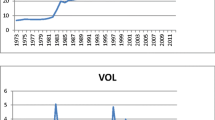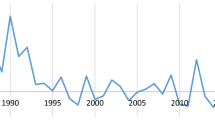Abstract
Impact of exchange rate uncertainty on trade flows still continues to dominate the literature. Most previous research has used aggregate trade data between one country and the rest of the world or between two countries at a bilateral level. A recent study, however, considered the trade between the U.S. and China at the commodity level, but excluded the “third-country” effect in its analysis. In this paper, we consider the commodity trade between the U.S. and China one more time and investigate whether volatility of the real U.S. dollar-Canadian dollar has any implication on the trade flows between the U.S. and China. The answer happens to be in the affirmative, though a more significant third-country effect is found in the short run as compared to the long run.

Similar content being viewed by others
Notes
For more on China’s reform policies see Zhang (1999).
A review article by Bahmani-Oskooee and Hegerty (2007) shows that as a matter of fact, most studies have ignored the third-country effect in the literature.
Note that the market share of each industry is reported inside the parenthesis next to the name of each industry in Tbale 2. For example, 0.494 as market share of industry 031 means that this industry has almost 0.5% (not 5%) market share. These shares are defined as the ratio of each industry’s imports as a percent of total U.S. imports from China.
From the long-run coefficient estimates we also conclude that the U.S. income carries its expected positive sign in majority of the models, impying that economic growth in the U.S. is major determinant of U.S. imports from China. The real U.S. dollar-Chinese yuan rate also carries a significant coefficient in 51 cases. Furtheremore, the coefficient is expectedly positive in 31 industries and negative in 20 industries.
Note that there are three industries coded 599, 663, and 667 in which ECM t−1 carries a positive coefficient, implying adjustment away from equilibrium. Business cycles and shocks to exchange rate that iduces severe volatility could cause trade flows of these industries not to adjust.
Note that in 20 out of 29 models that are misspecified (due to significant RESET statistic), the third-country effect is insignificant, leaving our long-run analysis almost unchanged.
Once again for each industry, its market share is defined as that industry’s export as a % of total U.S. exports to China. These shares are reported inside the parenthesis next to the name of each industry in Table 5. Sum of all these shares add up to 77.25, implying that about 23% of the U.S. exports to China are by other industries for which data were not available.
For more on this effect see Bahmani-Oskooee (1986).
Note that there are three exporting industries coded 251, 654, and 812 in which ECM t−1 carries a positive coefficient, implying that in these three models adjustment is not toward long-run equilibrium.
It is possible that finding for certain industries might be sensitive to the choice of third country. Future research should explore this point.
References
Bahmani-Oskooee M (1986) Determinants of international trade flows: the case of developing countries. J Dev Econ 20:107–123
Bahmani-Oskooee M, Ardalani Z (2006) Exchange rate sensitivity of U.S. Trade flows: evidence from industry data. South Econ J 72:542–559
Bahmani-Oskooee M, Hegerty S (2007) Exchange rate volatility and trade flows: a review article. J Econ Stud 34:211–255
Bahmani-Oskooee M, Wang Y (2007) Impact of exchange rate volatility on commodity trade between U.S. and China. Econ Issues 12:31–54
Bahmani-Oskooee M, Bolhasani M (2008) The J-curve: evidence from commodity trade between Canada and the U.S. J Econ Financ 32:207–225
Bahmani-Oskooee M, Economidou C, Goswami GG (2005) How sensitive are Britain’s inpayments and outpayments to the value of the British Pound. J Econ Stud 32:455–467
Boyd D, Caporale GM, Smith R (2001) Real exchange rate effects on the balance of trade: cointegration and the marshall-lerner condition. Int J Financ Econ 6:187–200
Cushman DO (1983) The effects of real exchange rate risk on international trade. J Int Econ 15:45–63
Cushman DO (1986) Has exchange risk depressed international trade: the impact of third country exchange risk. J Int Money Financ 5:361–379
De Vita G, Abbott A (2004) Real exchange rate volatility and US exports: an ARDL bounds testing approach. Economic Issues 9:69–78
Halicioglu F (2007) The J-curve dynamics of turkish bilateral trade: a cointegration approach. J Econ Stud 34:103–119
Mohammadi H, Cak M, Cak D (2008) Wagner’s hypothesis: new evidence from turkey using the bounds testing approach. J Econ Stud 35:94–106
Pesaran M, Shin Y, Smith R (2001) Bound testing approaches to the analysis of level relationships. J Appl Econ 16:289–326
Siddiki JU (2000) Demand for money in Bangladesh: a cointegration analysis. Appl Econ 32:1977–1984
Tang TC (2007) Money demand function for Southeast Asian countries: an empirical view from expenditure components. J Econ Stud 34:476–496
Zhang Z (1999) China’s exchange rate reform and its impact on the balance of trade and domestic inflation. Asia Pac J Econ Bus 3:4–22
Author information
Authors and Affiliations
Corresponding author
Additional information
Mohsen Bahmani-Oskooee is Patricia and Harvey Wilmeth Professor of economics and director of the Center for Research on International Economics at the University of Wisconsin-Milwaukee. Jia Xu is a doctoral student in the department of economics at the University of Wisconsin-Milwaukee.
Valuable comments of an anonymous referee as well as those of the editor are greatly appreciated without implicating them.
Appendix
Appendix
1.1 Data Definition and Sources
Annual data over 1978–2006 period are used d to carry out the empirical analysis. They come form the following sources:
-
a.
World Bank.
-
b.
International Financial Statistics of IMF (CD-ROM).
-
c.
Chinese Statistical Yearbook.
1.2 Variables
Mi = Volume of imports of commodity i by the U.S. from China. Import value data for each commodity comes from source a. In the absence of price level for each commodity, as a second best deflator we followed Bahmani-Oskooee and Ardalani (2006) and Bahmani-Oskooee and Wang (2007) and used aggregate import price index for the U.S. to deflate the nominal imports of each commodity. The aggregate import price index comes from source b.
Xi = Volume of exports of commodity ii by the U.S. to China. Export value data for each commodity come from source a. Again since no price level was available for each commodity, we used aggregate export price index for the U.S. to deflate the nominal exports of each commodity. The aggregate export price index comes from source b.
YUS = Measure of the United States income. It is proxied by the real GDP. The data come from source b.
YC = China’s real GDP. Nominal GDP is deflated by CPI, the only price index available (1995=100). All data come from source c.
RE = Real bilateral exchange rate between U.S. dollar and yuan defined as (PUS.EX / PC) where, EX is nominal exchange rate defined as number of yuan per dollar; PUS is the price level in the U.S. measured by CPI and PC, the price level in China, again measured by CPI. The data for all three variables involved come from source b.
VCH = Variability measure of real bilateral yuan-dollar rate (RE). For each year we following Bahmani-Oskooee and Wang (2007) and many other recent studies (e.g. De Vita and Abbott 2004) and define it as the standard deviation of 12 monthly real bilateral rate (RE) within that year. Monthly CPI data and nominal exchange rate data come from source b.
VCAN = Variability measure of real bilateral U.S. dollar-Canadian dollar rate. Again, for each year we define it as the standard deviation of 12 monthly real U.S. dollar-Canadian dollar rate. Monthly CPI data and nominal exchange rate data to construct the real exchange rate come from source b.
Rights and permissions
About this article
Cite this article
Bahmani-Oskooee, M., Xu, J. Impact of exchange rate volatility on commodity trade between U.S. and China: is there a third country effect. J Econ Finan 36, 555–586 (2012). https://doi.org/10.1007/s12197-010-9126-y
Published:
Issue Date:
DOI: https://doi.org/10.1007/s12197-010-9126-y




